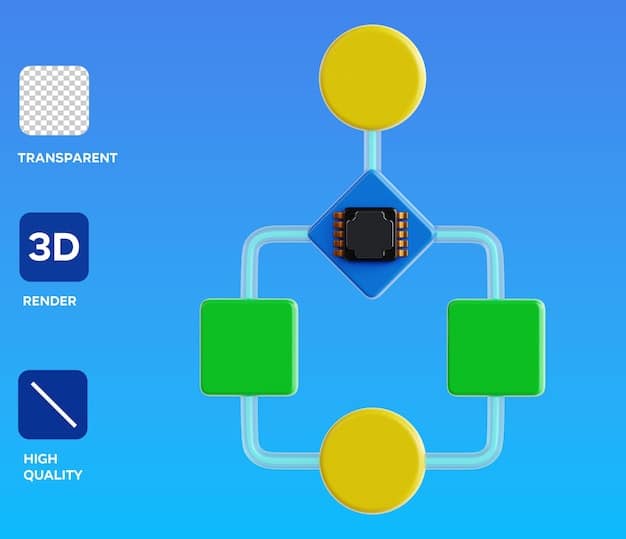Hyperparameter Tuning: Unlock 15% Higher Accuracy in ML Models

Hyperparameter tuning is the art and science of optimizing machine learning model performance, enabling you to achieve up to 15% higher accuracy by systematically exploring and selecting the best set of parameters for your model.
Want to unlock the full potential of your machine learning models? Hyperparameter tuning is the key to achieving significant performance gains, potentially boosting your accuracy by 15% or more. Let’s dive in!
Understanding Hyperparameters and Their Impact
Hyperparameters are the levers you can adjust to control the learning process of a machine learning model. Unlike model parameters that are learned during training, hyperparameters are set before training begins. Their values heavily influence how well a model learns and generalizes to new data.
Think of hyperparameters as the settings on a sophisticated oven. The oven represents your machine learning model, and the hyperparameters are like the temperature and cooking time. Setting them correctly determines whether you bake a perfect cake or end up with a burnt offering.
What are Hyperparameters?
Hyperparameters are external to the model and are not learned from the data. They dictate the structure of the model and how the learning algorithm behaves. Depending on the chosen values, the model might either underfit or overfit the data.
Consider these everyday analogies: if you’re training a child (the model), hyperparameters might be how many hours per day you tutor them (learning rate) or how strictly you enforce rules (regularization strength). These aren’t facts the child learns, but environmental factors influencing their learning.
Why Tuning Matters
Tuning hyperparameters is essential because it directly affects a model’s ability to find the optimal balance between bias and variance. A well-tuned model generalizes well to unseen data, leading to higher accuracy and improved performance in real-world applications.
Imagine a marksman trying to hit the bullseye. Without adjusting the sights on their rifle (hyperparameters), they might consistently shoot to the left (high bias) or have wildly scattered shots (high variance). Tuning allows them to zero in on the target with precision and consistency.

In conclusion, mastering hyperparameters is not just about tweaking knobs. It’s about understanding the fundamental principles of machine learning and applying that knowledge to optimize your models for peak performance.
Common Hyperparameter Tuning Techniques
Several effective techniques are available for hyperparameter tuning, each with its own strengths and weaknesses. Understanding these methods and when to apply them is crucial for efficient model optimization. Let’s explore some popular approaches.
Think of these techniques as different search strategies for finding the best hidden treasure. Some methods are systematic and thorough, while others are more explorative and opportunistic. Selecting the right approach depends on the terrain (your data and model) and the available resources (time and computing power).
- Grid Search: Exhaustively searches across a pre-defined subset of the hyperparameter space. It trains and evaluates the model for every possible combination of hyperparameters within the grid.
- Random Search: Randomly samples hyperparameter combinations from the search space. It typically outperforms grid search because it explores a wider range of values and avoids wasting time on unpromising regions.
- Bayesian Optimization: Uses a probabilistic model to guide the search, intelligently exploring the hyperparameter space by balancing exploration and exploitation. It learns from past evaluations to make informed decisions about which hyperparameters to try next.
- Gradient-Based Optimization: Employs gradients to optimize hyperparameters, treating them as model parameters. It leverages gradient descent or similar optimization algorithms to iteratively adjust hyperparameters for improved performance.
Grid search is like meticulously checking every square inch of a garden for buried treasure. Random search is like randomly digging holes, hoping to stumble upon something valuable. Bayesian optimization is like using a treasure map to guide your search based on past discoveries. Gradient-based optimization is like following a trail of clues to the hidden prize.
Pros and Cons of Each Technique
| Technique | Pros | Cons |
|---|---|---|
| Grid Search | Simple to implement, guarantees finding the best combination within the grid. | Computationally expensive, doesn’t scale well to high-dimensional spaces. |
| Random Search | More efficient than grid search, explores a wider range of values. | May miss the optimal combination, requires careful selection of the search space. |
| Bayesian Optimization | Intelligent search, learns from past evaluations, efficient in terms of evaluations. | More complex to implement, requires careful selection of the prior distribution. |
| Gradient-Based Optimization | Maximizes computing resources. | It can be complex to implement and depends heavily on the gradient and tuning on it. |
Selecting the right hyperparameter tuning technique involves considering the complexity of your model, the size of your dataset, and the available computational resources. Understanding their trade-offs allows you to make informed decisions and optimize your models effectively.
Setting Up Your Hyperparameter Tuning Environment
Before diving into hyperparameter tuning, it’s essential to set up a well-structured environment. This involves preparing your data, selecting appropriate evaluation metrics, and establishing a robust validation strategy. Let’s explore the critical components of a tuning environment.
Think of setting up your environment as preparing the kitchen before starting a complex recipe. Gather your ingredients (data), sharpen your knives (evaluation metrics), and organize your cooking stations (validation strategy) to ensure a smooth and efficient process.
- Data Preparation: Clean and preprocess your data to ensure its quality and suitability for training. Handle missing values, outliers, and inconsistent formats. Consider feature scaling or normalization to improve model convergence.
- Evaluation Metrics: Choose appropriate metrics to evaluate model performance based on your problem type. For classification, consider accuracy, precision, recall, F1-score, or AUC-ROC. For regression, consider mean squared error (MSE), root mean squared error (RMSE), or R-squared.
- Validation Strategy: Implement a robust validation strategy to reliably estimate model performance. Use techniques like k-fold cross-validation to partition your data into multiple training and validation sets, providing a more unbiased assessment of generalization ability.
Data preparation ensures that your model learns from high-quality information. Evaluation metrics provide a clear and quantifiable measure of your model’s effectiveness. A solid validation strategy ensures that your results are reliable and generalizable.
Consider using tools like scikit-learn, TensorFlow, or PyTorch to facilitate data preparation, evaluation, and validation. These libraries provide powerful functions and utilities for streamlining the hyperparameter tuning process.

Without a well-prepared environment, hyperparameter tuning can be a frustrating and time-consuming exercise. By investing in these foundational elements, you can set yourself up for success and achieve meaningful improvements in model performance.
Practical Tips for Effective Tuning
While hyperparameter tuning techniques provide a structured approach, some practical tips can significantly enhance your optimization efforts. These tips focus on understanding your model, choosing appropriate search spaces, and monitoring progress effectively.
Think of these tips as advice from experienced chefs who have mastered the art of baking. They offer insights into understanding your ingredients (model), setting the oven correctly (search space), and monitoring the cake as it bakes (progress).
Understand Your Model
Before attempting to tune hyperparameters, thoroughly understand your model’s behavior and sensitivities. Identify the key hyperparameters that have the most significant impact on performance. Consult documentation, research papers, and community discussions to gain insights into how different hyperparameters interact and affect the learning process.
Define a Reasonable Search Space
Carefully define the search space for each hyperparameter, considering their typical ranges and potential interactions. Avoid unnecessarily large or unbounded search spaces, as they can lead to inefficient exploration. Use domain knowledge and preliminary experiments to narrow down the search space to promising regions.
Monitor Progress and Adjust
Regularly monitor the progress of your tuning experiments, tracking key metrics like validation accuracy or loss. Visualize the performance of different hyperparameter combinations to identify trends and patterns. Be prepared to adjust your search space, tuning technique, or evaluation metric based on the observed results.
Understanding your model allows you to focus your tuning efforts on the most impactful hyperparameters. Defining a sensible search space prevents wasted exploration. Monitoring progress and adjusting the process mid-flight ensures that you’re always heading in the right direction.
- Start with a smaller subset of the data to quickly iterate and identify promising hyperparameter ranges.
- Use visualization tools to analyze the performance of different hyperparameter combinations.
- Don’t be afraid to experiment with unconventional hyperparameter values or combinations.
Common Pitfalls to Avoid
Hyperparameter tuning can be a challenging process, and several common pitfalls can hinder your progress. Being aware of these traps and implementing strategies to avoid them is crucial for maximizing the effectiveness of your tuning efforts. Let’s explore some of these potential problems.
Think of these pitfalls as hidden obstacles on a treasure hunt. Knowing where they lie and how to navigate around them can save you time, effort, and frustration.
- Overfitting to the Validation Set: Tuning hyperparameters excessively to improve performance on a specific validation set can lead to overfitting. The model may memorize the peculiarities of the validation set, resulting in poor generalization to unseen data.
- Ignoring Hyperparameter Interactions: Hyperparameters often interact with each other, influencing model performance in complex ways. Ignoring these interactions and tuning hyperparameters independently can lead to suboptimal results.
- Using Insufficient Computational Resources: Hyperparameter tuning can be computationally intensive, requiring significant time and resources. Attempting to tune with insufficient compute power can lead to slow progress and premature termination of experiments.
- Lack of Proper Documentation: Keeping a detailed record of your experiments, including hyperparameter values, evaluation metrics, and observations, is essential for reproducibility and understanding. Failing to document properly can lead to confusion, difficulty in recreating results, and wasted effort.
Overfitting to the validation set can make your model perform well on the test set but poorly on real datasets. Ignoring interactions can cause you to miss promising combinations of hyperparameters. Insufficient computational resources can slow down the process and limit the scope of your search. Lack of documentation can lead to confusion and hinder progress.
Advanced Techniques and Tools
Beyond the fundamental techniques, several advanced approaches and tools can further enhance your hyperparameter tuning capabilities. These techniques focus on automating the optimization process, leveraging distributed computing, and integrating with cloud platforms.
Think of these advanced techniques as upgrades to your treasure-hunting equipment. They provide enhanced tools for mapping the terrain, digging more efficiently, and analyzing your findings in real-time.
- Automated Machine Learning (AutoML): Leverage AutoML frameworks to automate the entire machine learning pipeline, including hyperparameter tuning, feature selection, and model selection.
- Distributed Hyperparameter Tuning: Utilize distributed computing frameworks like Apache Spark or Dask to distribute the tuning process across multiple machines, significantly reducing the total tuning time.
- Cloud-Based Tuning Services: Take advantage of cloud-based hyperparameter tuning services offered by providers like Amazon Web Services (AWS), Google Cloud Platform (GCP), and Microsoft Azure.
AutoML frameworks free you from tedious manual tasks, allowing you to focus on higher-level strategic decisions. Distributed tuning significantly accelerates the optimization process. Cloud-based services provide access to scalable resources and pre-configured environments.
By exploring these advanced techniques and tools, you can streamline your hyperparameter tuning workflow, unlock new levels of performance, and tackle complex machine learning challenges with greater efficiency and confidence.
| Key Concept | Brief Description |
|---|---|
| 🛠️ Hyperparameters | Adjustable settings that control the model’s learning process. |
| 🔍 Grid Search | Exhaustive search over predefined hyperparameter subsets. |
| 📊 Evaluation Metrics | Quantitative measures used to assess the model’s performance. |
| 🚀 AutoML | Frameworks that automate machine learning pipelines. |
[Frequently Asked Questions]
▼
Hyperparameter tuning optimizes model performance, improving accuracy, reducing overfitting, and ensuring better generalization to new data. These improvements often lead to more reliable and efficient models in real-world scenarios.
▼
The best technique depends on the specific problem, model, and available resources. Grid search is simple but computationally expensive. Random search is more efficient. Bayesian optimization is intelligent and adaptive, generally outperforming the other search methods given the resources available.
▼
Use k-fold cross-validation to evaluate performance robustly. Monitor validation metrics and avoid excessive tuning on a single validation set. Apply regularization techniques to penalize overly complex models which do not generalize well to unseen data.
▼
Evaluation metrics provide a quantitative measure of model performance. They guide the tuning process by indicating which hyperparameter combinations lead to better results. The appropriate metrics should align with the problem type (classification or regression).
▼
AutoML can automate much of the tuning process, but it’s not a complete replacement for human expertise. Understanding the problem and model is still essential. An understanding of evaluation metrics can still unlock greater model performance.
Conclusion
Hyperparameter tuning is a vital process, yet frequently overlooked in the pursuit of building high-performing machine-learning models. By understanding the impact of hyperparameters, mastering tuning techniques, and setting up a proper environment, you can unlock significant improvements in model accuracy and improve real-world applicability of these models. So, take the time to explore and optimize those hyperparameters—the results will be worth it.





